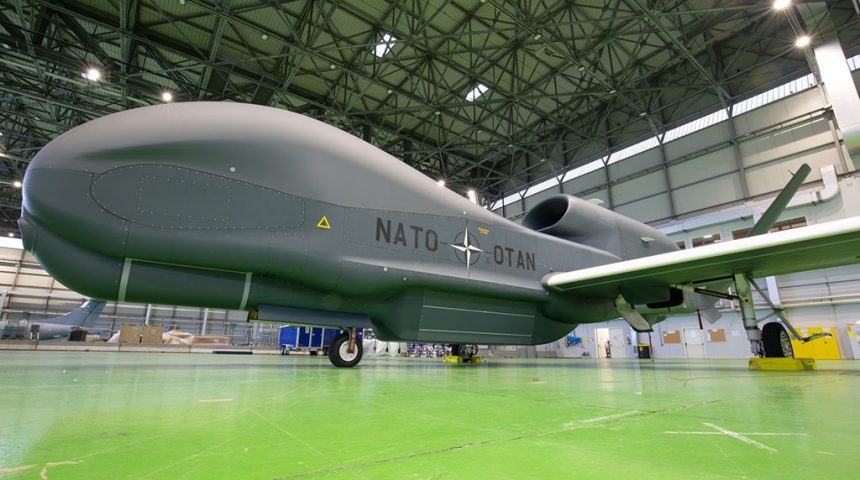The second of five RQ-4D Global Hawk has arrived at its new homebase in Sigonella, Italy, after a 20-hour flight from Edwards AFB.
On Dec. 19, 2019, at 14.39LT, the second Northrop Grumman Block 40 Global Hawk, also known as “Phoenix”, arrived at Sigonella Air Base, Italy. The aircraft flew from Edwards Air Force Base, California, where the aircraft took off on Dec. 18, at 08.40LT, and landed around 20 hours later at the MOB (Main Operating Base) of NATO’s AGS system. As happened during the previous crossing of the Atlantic Ocean from California to Italy on Nov. 21, the mission was entirely controlled by a pilot at the AGS (Alliance Ground Surveillance) Main Operating Base in Sigonella.
“This second ferry flight across the Atlantic is another major achievement on our road to establishing a leading-edge Intelligence Surveillance and Reconnaissance (ISR) capability for all NATO Allies,” said the NATO AGS Force Commander, Brigadier General Phillip Stewart, who oversees the standing up of the unit at the Italian Air Force Base in Sigonella, in an official release.
“Having received the second of five Phoenix aircraft here on schedule means that we can now continue developing the NATO AGS programme and work towards Initial Operational Capability in the coming months,” General Stewart stated.
The unmanned aircraft, that will use the callsign “MAGMA” when flying operational missions, should carry out the first flights from Sigonella in January. IOC is expected in the first half of 2020 and FOC within three years. Here are some interesting details posted by Aviation Week‘s London Bureau Chief Tony Osborne:
Yesterday, the NATO Alliance Ground Surveillance Force (NAGSF) gave an impressive brief about their progress at #Sigonella. I wrote on this here: https://t.co/LOS0dpolnD but thought I would tweet a new details about the program.
— Tony Osborne (@Rotorfocus) December 18, 2019
NAGSF has christened the platform “#Phoenix” in part because of its challenging upbringing, certification issues dogged the ability to perform delivery flights, but with support from USAF, the Italians were able to award the aircraft a type certificate in October. pic.twitter.com/nw3F6Igjfg
— Tony Osborne (@Rotorfocus) December 18, 2019
NAGSF is currently operating out “bridging” facilities at Sigonella, but work is underway on a new HQ, training and hangarage for the aircraft which is due to be fully ready in 2021. IOC for the AGS is expected in the first half of 2020 and then FOC within three years.
— Tony Osborne (@Rotorfocus) December 18, 2019
As already reported, the aircraft is based on the Northrop Grumman Block 40 Global Hawk operated by the U.S. Air Force, equipped with a state-of-the-art, multi-platform radar technology insertion programme (MP-RTIP) ground surveillance radar sensor, as well as an extensive suite of line-of-sight and beyond-line-of-sight, long-range, wideband data links. It will be used by the Alliance to perform all-weather ISR (Intelligence Surveillance and Reconnaissance) missions.
We have explained in detail what NATO AGS system in a recent article. Here’s once again an excerpt:
NATO’s AGS is a cooperative defense project to give the Alliance the ability to monitor “what’s happening on the ground, at long range, over periods of time, around the clock, in any weather” and to provide a state-of-the-art Intelligence, Surveillance and Reconnaissance (ISR) capability to NATO.
A group of 15 nations is acquiring the AGS, an integrated systems consisting of an air segment, a ground segment and a support segment.
The air segment consists of five NATO RQ-4D aircraft and remotely piloted aircraft (RPA) flight control elements.
The ground segment consists of a dedicated mission support facilities AGS MOB (Main Operating Base) in Sigonella, Italy, and a number of ground stations in mobile and transportable configurations, able to provide data-link connectivity, data-processing, exploitation capabilities and interfaces for interoperability.
According to NATO, “the ground segment will provide an interface between the AGS core system and a wide range of command, control, intelligence, surveillance and reconnaissance (C2ISR) systems. It will interconnect with multiple deployed and non-deployed operational users, as well as with reach-back facilities away from the surveillance area.”
While providing in-theatre situational awareness to commanders of deployed forces, the AGS system will be able to support a wide array of missions, going well beyond strategic or tactical reconnaissance: protection of ground troops and civilian populations; border control and maritime safety; anti-terror missions; crisis management and humanitarian assistance in natural disasters; as well as SAR support.
H/T our friend @CivMilAir for the heads-up!









